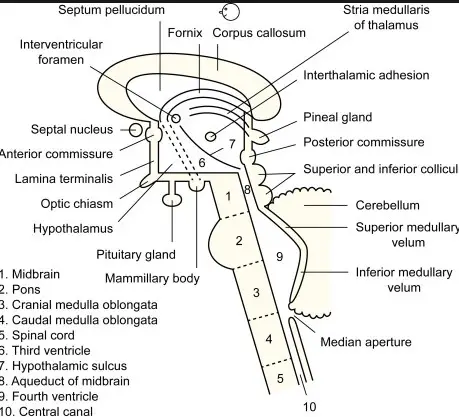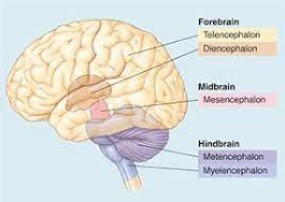The human brain, an intricate masterpiece of evolution, comprises numerous parts, each with a distinct role in governing our thoughts, emotions, and bodily functions. Among these, the telencephalon and diencephalon stand out for their critical functions in the central nervous system. These regions, though closely linked, serve different purposes that are vital for our everyday functioning.
The telencephalon, also known as the cerebrum, is the largest part of the brain and is primarily responsible for advanced cognitive functions such as reasoning, language, and voluntary motor activity. Conversely, the diencephalon acts as a relay center, facilitating communication between different brain regions and playing a key role in autonomic and endocrine functions. Understanding the differences between these two structures is fundamental to grasping the broader picture of how our brain operates.
While both regions are integral to the brain’s overall function, they are distinct in their structure, roles, and the way they interact with other parts of the brain. The telencephalon encompasses the cerebral cortex, responsible for higher order brain functions, while the diencephalon houses critical structures such as the thalamus and hypothalamus, which are pivotal in sensory and hormonal regulation. This separation of functions ensures the smooth processing of sensory information, the execution of motor functions, emotional regulation, and the maintenance of homeostasis.

Brain Anatomy Basics
Overview of Brain Structure
The human brain is a complex organ responsible for our thoughts, emotions, and bodily functions. Comprising over 86 billion neurons, it’s the control center for our entire body. The brain can be divided into three main parts: the cerebrum, the cerebellum, and the brainstem.
Role of the Cerebrum
The cerebrum is the largest part of the brain. It’s divided into two hemispheres (left and right) connected by a bundle of fibers called the corpus callosum. The cerebrum controls voluntary actions, sensory experiences, memory, and thought processes.
Significance of the Diencephalon
The diencephalon is located between the cerebrum and the brainstem. It plays a crucial role in sensory and motor signal relay, homeostasis, and the regulation of various bodily functions, including sleep and hunger.
Telencephalon Explained
Structure
Cerebral Hemispheres
The telencephalon includes the cerebral hemispheres, which are responsible for high-level brain functions. Each hemisphere is tasked with specific functions, with the left hemisphere often associated with logical thinking and language, and the right with creativity and spatial ability.
Lobes and Their Functions
- Frontal Lobe: Controls important cognitive skills, such as emotional expression, problem-solving, memory, language, and judgment.
- Parietal Lobe: Processes sensory information it receives from the outside world, mainly relating to touch, taste, and temperature.
- Temporal Lobe: Important for processing auditory information and is also key in the formation of long-term memory.
- Occipital Lobe: Responsible for visual processing.
Function
Cognitive Abilities
The telencephalon is pivotal in processing complex cognitive tasks, enabling reasoning, planning, and problem-solving.
Emotion and Memory
This brain region is crucial for emotional regulation and the formation and retrieval of memories.
Connectivity
White Matter Tracts
White matter tracts in the telencephalon facilitate communication between different parts of the brain.
Communication with Other Brain Regions
The telencephalon interacts extensively with other brain regions to coordinate high-level brain functions, including sensory processing, voluntary movement, and complex cognitive processes.
Diencephalon Overview
Structure
Thalamus
The thalamus acts as the brain’s relay station, directing sensory and motor signals to the cerebral cortex.
Hypothalamus
The hypothalamus plays a crucial role in the endocrine system, regulating hunger, thirst, sleep, and emotional activity.
Function
Sensory Relay Station
The diencephalon acts as a hub for sensory information, filtering essential data to the cerebrum.
Homeostasis and Hormone Regulation
It is key in maintaining the body’s internal balance and regulating the secretion of hormones through its connection with the pituitary gland.
Connectivity
Links to the Endocrine System
The diencephalon has direct connections with the endocrine system, influencing the body’s hormonal environment.
Integration with the Limbic System
It plays a significant role in the limbic system, impacting emotions, and long-term memory formation.

Comparing Telencephalon and Diencephalon
Functional Differences
Cognitive vs. Regulatory Roles
The telencephalon is primarily associated with cognitive functions, such as thinking, learning, memory, and voluntary movement. It’s the seat of our higher intellect, allowing for complex problem-solving and creativity. On the other hand, the diencephalon plays a pivotal regulatory role, overseeing essential bodily functions like temperature regulation, hunger and thirst, and the sleep-wake cycle. It acts as a command center for balancing the body’s internal environment.
Structural Differences
Physical Location and Composition
Structurally, the telencephalon encompasses the cerebral hemispheres, including the cerebral cortex and underlying structures such as the hippocampus and basal ganglia. The diencephalon, conversely, is situated beneath the cerebral hemispheres and includes the thalamus and hypothalamus. These differences in location and composition underscore the distinct functions of each region.
Connectivity and Interaction
How They Work Together
Despite their differences, the telencephalon and diencephalon are interconnected, working synergistically to process information and respond to internal and external stimuli. The thalamus in the diencephalon plays a critical role in relaying sensory and motor signals to the cerebral cortex in the telencephalon, integrating the cognitive and regulatory functions of the brain.
Evolutionary Perspective
Evolution of the Telencephalon and Diencephalon
The evolution of the telencephalon and diencephalon reflects the increasing complexity of vertebrate brains. The telencephalon has expanded significantly in mammals, especially in primates, correlating with advancements in cognitive abilities and social behaviors. The diencephalon’s evolution has been more conservative, maintaining its fundamental role in sensory integration and homeostasis across different species.
Comparative Anatomy in Different Species
Comparing the telencephalon and diencephalon across species highlights their evolutionary adaptation. In mammals, the telencephalon shows remarkable enlargement and complexity, particularly in areas involved in sensory perception, voluntary movement, and cognitive processing. In contrast, the diencephalon remains relatively consistent in size but varies in its connections and functionality, reflecting adaptations to specific environmental challenges and life strategies.
Clinical Relevance
Disorders Affecting Telencephalon
Alzheimer’s Disease
Alzheimer’s disease primarily affects the telencephalon, leading to the degeneration of cerebral cortex cells. This results in memory loss, cognitive decline, and changes in personality and behavior. Alzheimer’s disease underscores the critical role of the telencephalon in memory and cognitive functions.
Stroke Impact
A stroke in the regions of the telencephalon can severely affect motor skills, language, and sensory processing. The extent of impairment depends on the stroke’s location within the telencephalon, highlighting its role in various cognitive and motor functions.
Disorders Affecting Diencephalon
Thalamic Syndrome
Thalamic syndrome results from damage to the thalamus, part of the diencephalon, leading to chronic pain, sensory disturbances, and, in some cases, emotional instability. This condition illustrates the thalamus’s role in processing and relaying sensory information to the cerebral cortex.
Hypothalamic Dysfunction
Hypothalamic dysfunction can disrupt the body’s homeostasis, affecting temperature regulation, hunger, thirst, and sleep patterns. Such dysfunctions can stem from tumors, injuries, or genetic disorders, emphasizing the hypothalamus’s regulatory importance.
Treatment and Research
Current Treatments
Treatments for disorders affecting the telencephalon and diencephalon vary based on the condition’s nature and severity. They may include medication, surgery, physical therapy, and innovative approaches like deep brain stimulation. These treatments aim to restore function or alleviate symptoms associated with the affected brain regions.
Future Research Directions
Ongoing research focuses on better understanding the pathophysiology of diseases affecting these brain regions and developing more effective and personalized treatment strategies. Advances in neuroimaging, genetics, and molecular biology hold promise for unveiling new insights into the telencephalon and diencephalon’s roles in health and disease.

Frequently Asked Questions
What is the Telencephalon?
The telencephalon, or cerebrum, is the uppermost part of the brain, encompassing the cerebral hemispheres. It is responsible for higher cognitive functions, including thinking, planning, language, sensory processing, and voluntary movement. This region is characterized by its complex structure of folds and grooves, housing the brain’s advanced processing capabilities.
How Does the Diencephalon Function?
The diencephalon is a crucial part of the brain located beneath the cerebrum, playing a central role in relaying sensory information, regulating autonomic functions, emotions, and endocrine processes. It includes major components like the thalamus, which acts as a sensory relay station, and the hypothalamus, which is vital for hormonal and homeostatic regulation.
What are the Main Differences Between Telencephalon and Diencephalon?
The primary differences between the telencephalon and diencephalon lie in their structure, location, and function. The telencephalon includes the cerebral cortex and is involved in high-level cognitive functions and voluntary actions. The diencephalon, on the other hand, serves as a relay for sensory and motor pathways and regulates vital autonomic and endocrine functions.
Why is Understanding These Brain Regions Important?
Understanding the telencephalon and diencephalon is crucial for comprehending how the brain processes sensory information, controls movement, regulates emotions, and maintains bodily functions. This knowledge is fundamental for medical professionals in diagnosing and treating neurological conditions that affect these specific areas of the brain.
Conclusion
The intricate workings of the telencephalon and diencephalon underscore the complexity and elegance of the human brain. Each region plays a pivotal role in our daily lives, from the basic regulation of bodily functions to the sophisticated processes of thought, language, and emotion. Recognizing the distinct functions and structures of these brain regions not only enriches our understanding of human biology but also enhances the development of medical treatments targeting neurological disorders.
As we continue to explore the depths of the human brain, the knowledge of these two critical areas illuminates the path toward unlocking the mysteries of the mind. The difference between the telencephalon and diencephalon exemplifies the specialized nature of brain regions, highlighting the importance of each in maintaining the delicate balance that allows us to interact with and interpret the world around us.

